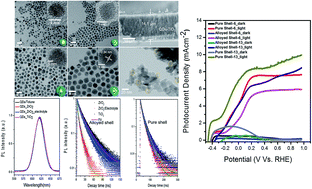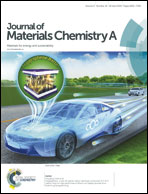Heterostructured quantum dot architectures for efficient and stable photoelectrochemical hydrogen production†
Abstract
The long term stability of photoelectrochemical (PEC) devices based on colloidal quantum dots (QDs) for hydrogen production is a major challenge. The degradation is often caused by the self-oxidation of QDs induced by the excess accumulation of holes in the valance band. Here, we use heterostructured “giant” core/alloyed-shell CdSe/PbxCd1−xS/CdS QDs to sensitize TiO2 mesoporous films for PEC hydrogen production. Transient fluorescence analysis results show that the use of a PbxCd1−xS gradient layer leads to a three-fold increase in the hole transfer rate compared to a pure CdS shell with similar shell thickness. The as-prepared PEC cell using alloyed shell “giant” QDs exhibits an enhanced photocurrent density of 10.2 mA cm−2 (97 mL per cm2 per day) under one sun illumination (100 mW cm−2). The PEC cell based on alloyed shell “giant” QDs shows an enhanced PEC device stability, with retention of ∼94.9% of its initial photocurrent after 2 h under one sun illumination. This finding provides unique insights to improve the stability and functional performance of PEC devices in which the photoanode is sensitized using colloidal “giant” QDs.



 Please wait while we load your content...
Please wait while we load your content...